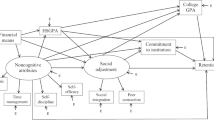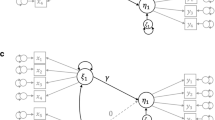Abstract
Most studies of persistence behavior use path analysis or ordinary least squares regression to estimate unknown coefficients. However, estimates produced by these techniques are biased if selectivity bias contaminates choices made by individuals in the data sample. We explain this problem, argue that it is present in data samples used in persistence studies, and discuss an alternative estimation technique that controls for it. The methodology and the differences in the interpretation of coefficient estimates are illustrated with a data sample of individual students at a single university.
Similar content being viewed by others
References
Aitken, N. D. (1982). College student performance, satisfaction, and retention: Specification and estimation of a structural model.Journal of Higher Education 53: 32–50.
Bean, J. P. (1982). Student attrition, intentions, and confidence: Interaction effects in a path model.Research in Higher Education 17: 291–320.
Berndt, E. K., Hall, B. H., Hall, R. E., and Hausman, J. A. (1974). Estimation and inference in nonlinear structural models.Annals of Economic and Social Measurement 3: 653–665.
Broughton, V. J. (1986). A causal analysis of attrition at an urban non-residential university. ERIC Document Reproduction Services No. ED 280 411.
Kohen, A. I., Nestel, G., and Karmas, C. (1978). Factors affecting individual persistence rates in undergraduate college programs.American Educational Research Journal 15: 233–252.
Maddala, G. S. (1983).Limited-Dependent and Qualitative Variables in Econometrics. New York: Cambridge University Press.
Murnane, R. J., Newstead, S., and Olsen, R. J. (1985). Comparing public and private schools: The puzzling role of selectivity bias.Journal of Business and Economic Statistics 3: 23–35.
Pascarella, E. T. (1985). Racial differences in factors associated with bachelor's degree completion: A nine year follow-up.Research in Higher Education 23: 351–373.
Pascarella, E. T., and Chapman, D. W. (1983a). A multiinstitutional, path analytic validation of Tinto's model of college withdrawal.American Educational Research Journal 20: 87–102.
Pascarella, E. T., and Chapman, D. W. (1983b). Validation of a theoretical model of college withdrawal: Interaction effects in a multi-institutional sample.Research in Higher Education 19: 25–48.
Pascarella, E. T., Terenzini, P. T., and Wolfe, L. M. (1986). Orientation to college and freshman year persistence/withdrawal decisions.Journal of Higher Education 57: 155–175.
Terenzini, P. T., Pascarella, E. T., Theophilides, C., and Lorang, W. G. (1985). A replication of a path analytic validation of Tinto's theory of college student attrition.Review of Higher Education 8: 319–340.
Tinto, V. (1975). Dropout from higher education: A theoretical synthesis of recent research.Review of Educational Research 45: 89–125.
Willis, R. J., and Rosen, S. (1979). Education and self-selection.Journal of Political Economy 87: S7-S36.
Author information
Authors and Affiliations
Rights and permissions
About this article
Cite this article
Weiler, W.C., Pierro, D.J. Selection blas and the analysis of persistence of part-time undergraduate students. Res High Educ 29, 261–272 (1988). https://doi.org/10.1007/BF00992926
Received:
Issue Date:
DOI: https://doi.org/10.1007/BF00992926




